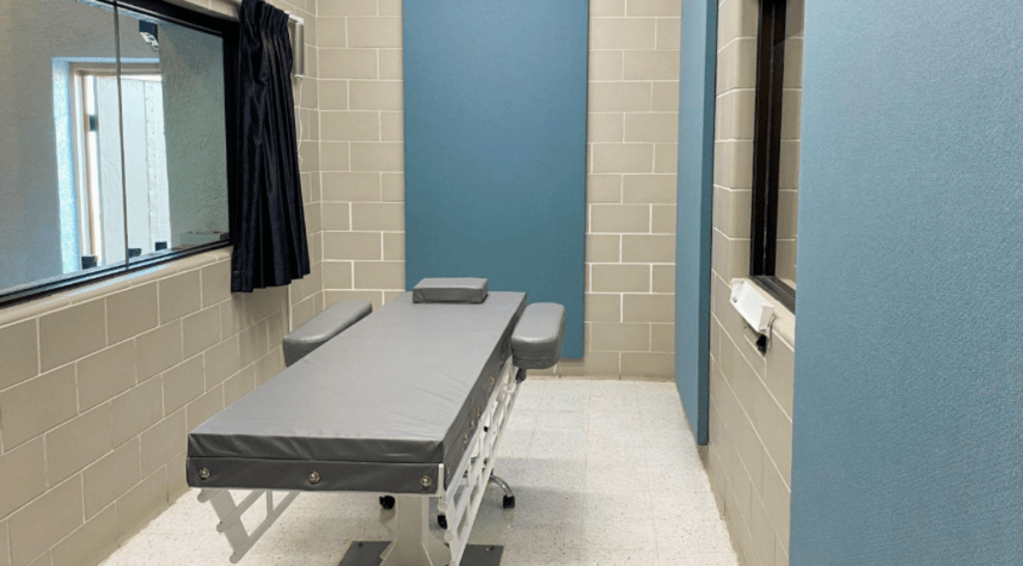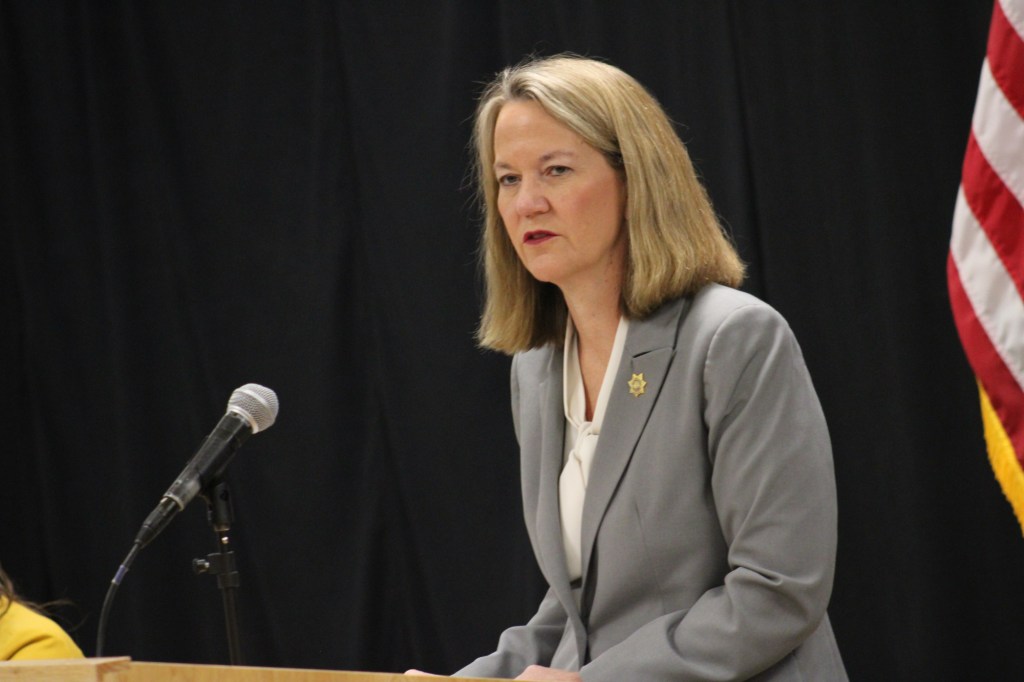
Arizona Department of Corrections, Rehabilitation and Reentry

Audio By Carbonatix
Shortly after 10:30 a.m. Friday, the state of Arizona executed its second death row prisoner under the administration of Democratic Gov. Katie Hobbs.
Richard Djerf, who was on death row after committing the heinous 1993 murders of four family members in an act of revenge against a coworker, died by lethal injection at the Arizona State Prison Complex-Florence. Witnesses reported that his execution appeared to go smoothly, though execution staff had some trouble inserting needles into Djerf’s veins. Djerf was 55 years old.
Arizona also killed Aaron Gunches earlier this year. Gunches was the first death row prisoner executed since Hobbs took office in 2023. The Democratic governor had initially paused executions after a series of flawed killings carried out in the waning days of Republican Gov. Doug Ducey’s administration. But Hobbs restarted the execution process earlier this year, firing a retired judge she’d hired to audit the state’s procedures.
Djerf spent nearly 30 years on death row, housed in the Arizona State Prison Complex-Tucson. He was 23 years old when he exacted the brutal revenge for an alleged robbery committed by coworker Albert Luna Jr. In September 1993, Djerf held Luna’s family hostage at gunpoint in their west Phoenix home. He raped and killed Luna’s 18-year-old sister, bashed his father’s head with a baseball bat and shot Luna’s father, mom and five-year-old brother. Djerf then doused the room in gasoline, turned on the stove burners and left in the family’s car, which he had forced Luna’s mother to load with household items earlier in the day.
We’re thankful for you. Are you thankful for us?
We feel thankful for our staff and for the privilege of fulfilling our mission to be an unparalleled source of information and insight in Phoenix. We’re aiming to raise $30,000 by December 31, so we can continue covering what matters most to this community.
Help us continue giving back to Phoenix.
Luna Jr. was not present when Djerf committed the murders and did not attend Djerf’s execution.
In 1996, Djerf pleaded guilty to four counts of first-degree murder and was sentenced to death. Earlier this summer, Arizona Attorney General Kris Mayes sought a death warrant for Djerf, which the Arizona Supreme Court granted on Aug. 19. Djerf did not fight his own state-imposed death. He exhausted the last of his appeals in 2019 and did not seek clemency from Hobbs. In a letter released to the Arizona Republic ahead of his execution, Djerf expressed remorse for his actions and said he couldn’t think of a reason for his life to be saved.
According to the corrections department, Djerf’s last meal was a double cheeseburger with onion rings, a slice of cherry pie with whipped cream and a 10-ounce Pepsi with ice. Media witnesses said the 5-foot-6, 230-pound Djerf stiffly walked into the execution chamber escorted by five execution staffers. He wore an all-white short-sleeved jumpsuit and black flip-flops. He laid on the execution table and was restrained across his chest, arms and legs. Media witness John Hook of Fox 10 said Djerf was “very compliant.”
Djerf was then covered by a white sheet up to his chest. He did not look into the observation room where witnesses gathered, including Mayes and Maricopa County Attorney Rachel Mitchell. None of the victims’ surviving family members attended the execution and it appeared no one attended on Djerf’s behalf either.
Djerf kept his eyes closed during the entire ordeal, according to media witness Hector Lagunas of Univision. When he was asked if he had any final words, he responded, “I do not.”

Arizona Department of Corrections, Rehabilitation and Reentry
IV issues
Though media witness Briana Whitney of Arizona’s Family said Djerf “looked very calm” during the lead-up to his execution, she said that Djerf told her ahead of his execution he had anxiety about people watching him die.
That process was apparently prolonged as the execution team had a “really difficult time” inserting the IVs into both of Djerf’s arms, Hook said. They “kept poking him” with the needles and cleaning up blood from his arms, Lagunas added. It took nearly 10 minutes for the IVs to be inserted, as they were taken out and reinserted at least four times. Djerf remained “motionless” throughout this process.
“They were having a really difficult time finding a suitable vein to administer the needle,” Hook said. “That was clear.”
Arizona Department of Corrections, Rehabilitation and Reentry deputy director John Barcello said Djerf was injected with a fatal dose of pentobarbital at 10:24 a.m. and died 16 minutes later. Media witnesses said the execution appeared to go much quicker than that. After the drugs were injected into Djerf, he let out a few puffs of air and his chest went up and down a few times. By 10:30 a.m., his breathing was shallow. Two minutes later, Djerf wasn’t breathing or moving and his face was drained of color and was a blueish-gray hue.
“I have onset of death, from start to finish, six minutes,” said Hook. Whitney added that the execution “seemed to go very routine. It felt very peaceful. It felt very clinical. There seemed to be no struggle or pain from Richard Djerf during this time frame.”
Pentobarbital is meant to quickly render a person unconscious before quickly stopping the body’s core functions. But death penalty experts warned before Djerf’s execution that it could be far more painful than it appears. Both retired magistrate judge David Duncan — whom Hobbs fired before he could issue his final report on Arizona’s execution practices — and lethal injection expert Corinna Barrett Lain noted that prisoners who die by lethal injection with pentobarbital often suffer pulmonary edema while not fully anesthetized, meaning they painfully die as their lungs fill up with fluid.
An autopsy of Gunches showed no signs of pulmonary edema, but many patients killed by pentobarbital do show such signs. Whether Djerf suffered pulmonary edema will not be clear until the medical examiner’s report on his death is released.

Morgan Fischer
More executions to come
If Djerf’s death did go smoothly — aside from the issues of placing the IV — that’s a change of pace from Arizona’s previous execution regime.
Arizona has a history of botched executions. In 2014, Arizona used a two-drug protocol to kill death row prisoner Joseph Wood. That execution lasted nearly two hours, which was the longest execution in U.S. history at the time. Wood gasped for breath more than 640 times and he was injected with the lethal injection cocktail 15 times, according to Lain’s book “Secrets of the Killing State.”
After Wood’s brutal death, Arizona halted executions for eight years but resumed them toward the end of Ducey’s administration in 2022. That year, three death row prisoners were killed in quick succession. Each time, problems arose. Hobbs and Mayes again halted executions when they took office in 2023, and Hobbs tapped Duncan to review the state’s protocols. But on the eve of the release of Duncan’s report last year, Hobbs unceremoniously fired him, citing that he had overstepped the bounds of his duties.
Notably, a draft version of Duncan’s report suggested there was no humane and practical way to kill prisoners by lethal injection and said the firing squad, which is illegal in Arizona, would be less prone to screw-ups. At the same time, Mitchell was agitating for Gunches’ execution and seeking to go around Mayes, who possesses the authority to seek death warrants, to make it happen. Mayes sought a death warrant for Gunches before the question of Mitchell’s authority in the matter could be tested in court.
Ahead of Gunches’ execution, there were questions about the provenance and efficacy of the state’s lethal injection drugs. Gunches’ execution went relatively smoothly, however, and in a statement prior to Djerf’s execution, the corrections department said it was “confident in both the quality and quantity of its pentobarbital supply.” It added that “appropriate testing occurred earlier this year” and a “sufficient concentration of pentobarbital” was present in the solution that was to be injected into Djerf.
After Djerf’s execution, Mitchell issued a statement that said: “Richard Djerf is a prime example of why the death penalty exists. What this man did in 1993, torturing and murdering nearly an entire family, was pure evil. Today was a day of final justice — not only for the memory of the four innocent lives he took, but also for the only surviving son and the extended Luna family, who have carried the weight of that loss every single day.”
Arizona now has 108 prisoners on death row, including dozens who have exhausted all appeals. Executions are expected to continue in Arizona. In a press briefing after the execution, Mayes emphasized that “the death penalty is the law of the land in Arizona.”
“To the Luna family and other crime victims like them, know that the Arizona Attorney General’s Office will fight for the justice that you deserve,” she said.